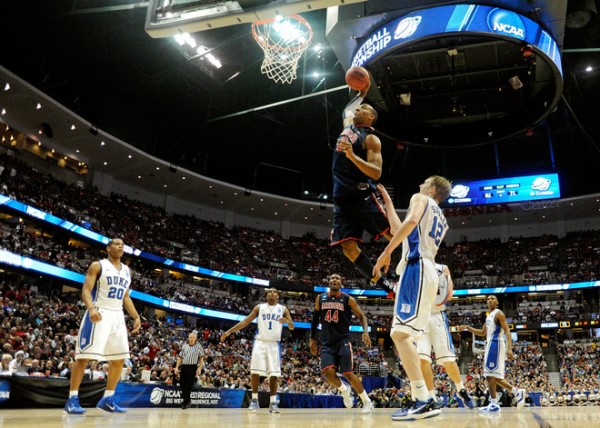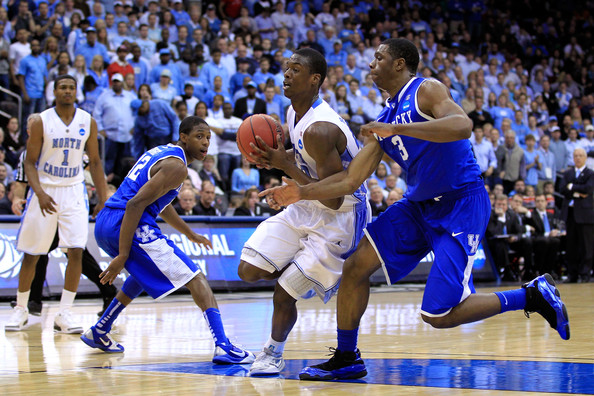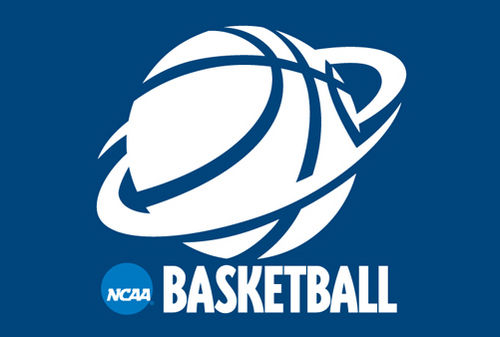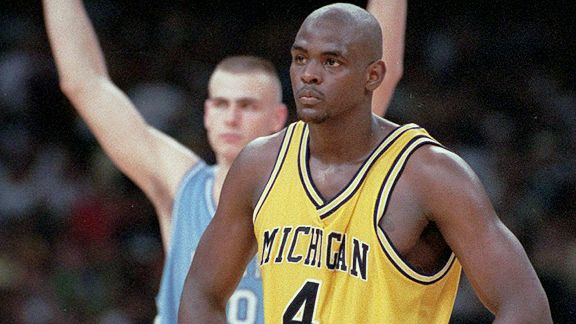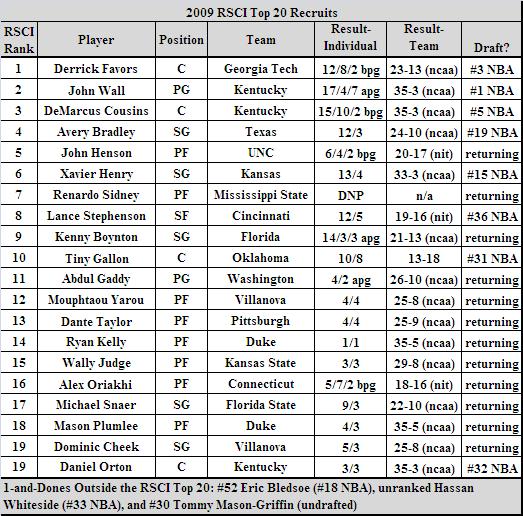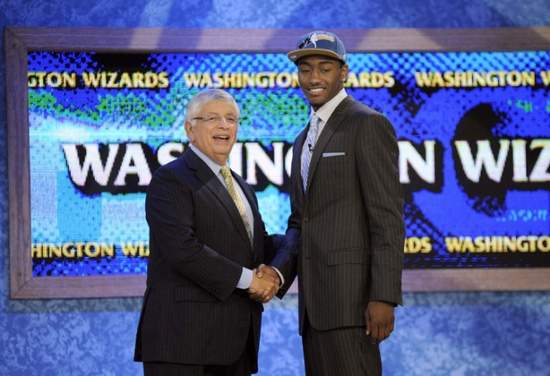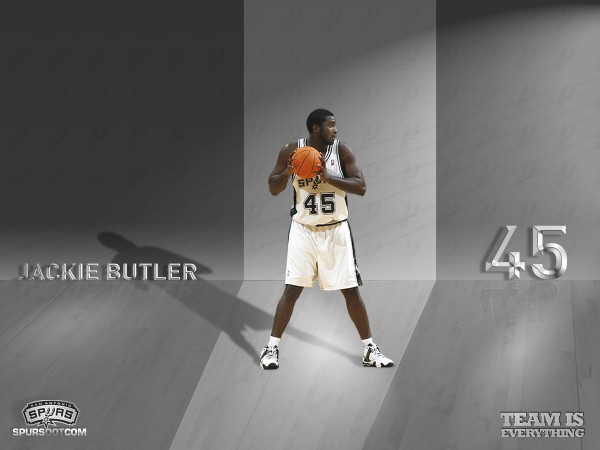Posted by rtmsf on June 27th, 2008
Thanks to N-Bug’s liveblog of the NBA Draft last night, we felt like we were almost in the building sniffing David Stern’s manscent and Darrell Arthur’s ire. What’s the record for lowest pick of someone in the Green Room? The best we can muster is Rashard Lewis at #32 ten years ago. Anyone got a lower pick left stewing in the Green Room all night?

Unfounded Rumors of a Kidney Problem Sunk Arthur’s Stock (photo credit: AP)
Darrell Arthur’s Kidney. The story of last night’s draft, of course, was the unsubstantiated rumor of a serious undisclosed kidney problem that arose during Darrell Arthur’s medical tests. Luke Winn details the report much better than we can here, but suffice it to say that it now appears that this kidney issue was a complete red herring, and the Memphis Grizzlies (through two subsequent trades) got an absolute steal at the #27 slot. Winn suggests that the whispers about Arthur’s health could have cost him in the neighborhood of $1.3M over the course of his rookie contract. Shouldn’t we just go ahead and put Slim Shady at the top of next year’s ROY contenders (Paul Pierce-style) based upon this slight alone? He’ll have gobs of additional motivation, that’s for sure.
One-and-Done Redux. We’ve written about 1-and-dones until we’re blue in the face, but let’s face it, the Class of 2007 is arguably one of the greatest HS classes of all-time. Four of the top five picks, seven of the top fourteen, and a record ten of the thirty first-rounders were freshmen. Throw in the eight sophomores chosen in the first round, and that means 72% of the guaranteed contracts that went to American players were to players with 2 years or less of college experience. Only five seniors were chosen in the first round, and the first at #12 overall, Jason Thompson from Rider, resulted in a perplexed “who?” from much of the crowd and viewing audience. Again, there is no question that the NBA rule helped in terms of marketing these players. Thanks to the Season of the Freshman, every basketball fan in America is now intimately familiar with the games of Derrick Rose, Michael Beasley, OJ Mayo, Kevin Love, and so on. If they’d all gone pro after high school, we’d have little to no clue what those teams were getting.

Mayo Posing as Stringer Bell (photo credit: SI.com)
Beautiful Disasters. Two of the one-and-dones who were bound and determined to stay in the draft no matter what anyone told them were DeAndre Jordan and Bill Walker. (note: we were happy to see that our feelings of overratedness (see: HoopsAddict podcast at 34:30) with Jordan and Anthony Randolph were corroborated on draft night, although not so much with Russell Westbrook, chosen fourth!) Both got drafted in the second round (#35 and #47 respectively) but last night had to be severely disappointing to both players, as Jordan was being talked about as a lottery pick earlier this draft season, and Walker last year (before blowing out his knee again). Does Walker with his former #1 player in his class pedigree and seemingly constant knee injuries remind anyone else of Randy Livingston? But the prize for biggest clowns of the draft go to USC’s Davon Jefferson and Mississippi State’s Jamont Gordon, both of whom were undrafted last night. As for Jefferson, this one-and-done prospect declared early, signed with an agent (assuring he couldn’t return to USC), and then proceeded to float his way through the pre-draft camp. He was a possible second-rounder at that point, but his uninspired effort in Orlando ensured that he would be left on the outside looking in. Gordon’s situation was even worse, as he completely skipped the pre-draft camp (incredulously assuming he was a first-rounder), also signed with an agent, and otherwise did nothing to show that he was a serious candidate for the draft. Ok, we get it, you reallyreallyreallyreally want to play in the NBA, and you reallyreallyreallyreally think you’re good enough… but you guys really need to start doing some listening when people who make these decisions (scouts, GMs, draftniks) are telling you otherwise. Good luck in the D-League, guys.
Katz discusses some of the other early entry disappointments in last night’s draft.

Sideshow Bob Was Drafted by the Suns Last Night (photo credit: SI.com)
Conference Call. A year ago Pac-10 coaches were telling us that they had far and away the most talent in the nation, suggesting that there are as many as a dozen first-round picks on their squads in 2007-08. Well, it turns out they weren’t that far off, as there were seven first rounders last night, including three of the top five (#3 Mayo, #4 Westbrook, #5 Love, #10 Brook Lopez, #11 Jerryd Bayless, #15 Robin Lopez, #21 Ryan Anderson), and twelve players chosen overall. Also keep in mind that several other probable first rounders from the Pac-10, such as Darren Collison (UCLA), Chase Budinger (Arizona) and Jeff Pendergraph (Arizona St.) elected to stay in college another year. The Big 12 was next with nine players chosen, including four first rounders and five (!!) players – tying the 2006 UConn Huskies and 2007 Florida Gators – from the National Champs (#13 Brandon Rush, #27 Darrell Arthur, #34 Mario Chalmers, #52 Darnell Jackson, #56 Sasha Kaun). Throw in former Jayhawk JR Giddens (#30) and an astonishing six players passed through the KU program en route to this draft. The SEC had six draft picks, and the Big East and ACC had four each. The usually-pathetic Big 10 once again finished last among the BCS conferences with only three picks. See table below.

Not NBA Material. We reserve this spot to formally bid adieu to some of the notable collegians who have entertained us for the last four years, but whom the NBA has decided are not worthy to play in their league. Drew Neitzel (Michigan St.), Demarcus Nelson (Duke), David Padgett (Louisville), Josh Duncan (Xavier), and Pat Calathes (St. Joseph’s) are but a few of the names we’ll probably never see again unless they become coaches someday. The honor of the biggest undrafted name, though, goes to Tennessee star and cancer survivor Chris Lofton, who holds the all-time mark in the SEC for three-pointers, and ranks third in NCAA history on that measure. If there’s one guy we’d bank on finding his way to an NBA court near you in the next couple of years (even for a cup of coffee), it would probably be this kid. He stares toughness and grit directly in the eyes before they walk away in shame.
| nba draft
| Tagged: 1-and-done, acc, anthony randolph, arizona, arizona st, big 10, big 12, big east, bill walker, brandon rush, brook lopez, california, chase budinger, chris lofton, class of 2007, darnell jackson, darrell arthur, darren collison, david padgett, davon jefferson, deandre jordan, demarcus nelson, derrick rose, drew neitzel, duke, green room, jamont gordon, jasnon thompson, jeff pedergraph, jerryd bayless, josh duncan, jr giddens, kansas, kansas st, kevin love, louisville, lsu, mario chalmers, memphis, michael beasley, michigan st, mississippi st, nba draft, new mexico, oj mayo, pac-10, pat calathes, rashard lewis, rider, robin lopez, russell westbrook, ryan anderson, sasha kaun, sec, st joseph's, stanford, stock sliding, tennessee, texas a&m, ucla, usc, xavier
Share this story






























